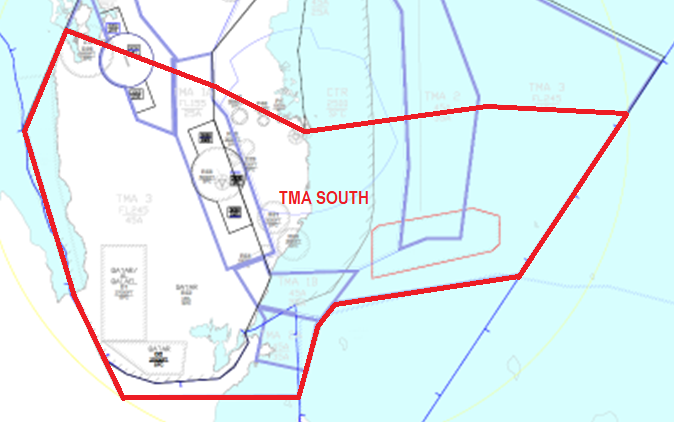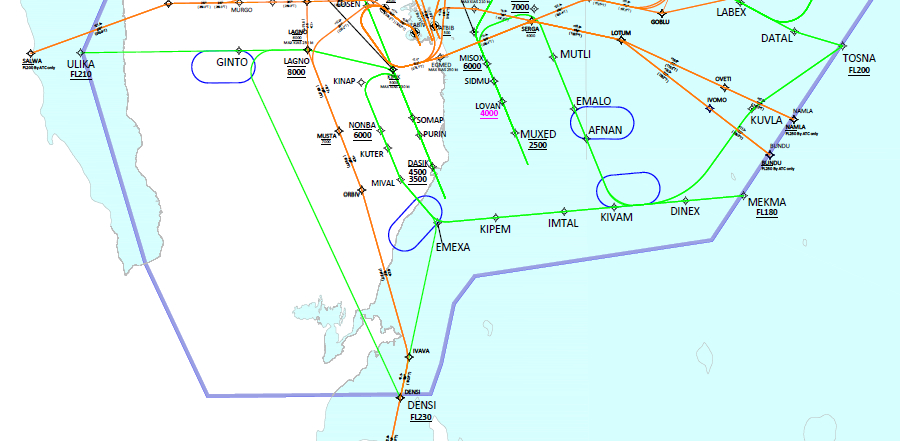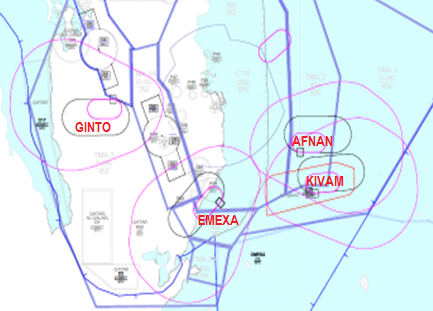QCAA Enhanced Airspace Theoretical Training

-
TMA South
- INTRODUCTION
- Start page
- Welcome to the training
- Structure of the course
- DOHA TMA SECTORS
- Sectors Section structure
- Opening page for Sectors section
- Callsign and frequency allocation
- TMA North
- Test TMA North
- TMA North RWY15/16
- TMA South
- Test TMA South
- TMA South RWY33/34
- TMA South RWY15/16
- APP East
- Test APP East
- APP East RWY 33/34
- APP East RWY 15/16
- APP West
- Test APP West
- APP West RWY15/16
- APP West RWY33/34
- DIR East
- Test DIR East
- DIRECTOR East RWY33/34
- DIR West
- Test DIR West
- DIRECTOR West RWY 15/16
- STANDARD INSTRUMENT DEPARTURES, SIDs
- Opening page for SIDs section
- SIDs RWY15/16
- SIDS RWY 16L
- SIDs RWY 16L
- ALSEM 2M - NAMLA 2M - VAXIN 2M
- ALSEM 2M - NAMLA 2M - VAXIN 2M vs. Interacting STA...
- ALVEN 2M - LUBET 1M - PATOM 2M
- ALVEN 2M - LUBET 1M - PATOM 2M vs. Interacting STA...
- SIDs 16L completed
- SIDS RWY 16R
- SIDs RWY 16R
- BATHA 2C - SALWA 2C
- BATHA 2C - SALWA 2C vs. Interacting STARs
- BUNDU 2C
- BUNDU 2C vs. Interacting STARs
- TULUB 1C
- TULUB 1C vs. Interacting STARs
- SIDS RWY 15
- SIDs RWY 15
- ALSEM 2S - BUNDU 2S - NAMLA 2S - VAXIN 2S
- ALSEM 2S - BUNDU 2S - NAMLA 2S - VAXIN 2S vs. Inte...
- ALVEN 2S - LUBET 1S - TULUB 1S
- ALVEN 2S - LUBET 1S - TULUB 1S vs. Interacting STA...
- BATHA 2S - SALWA 2S
- BATHA 2S - SALWA 2S vs. Interacting STARs
- PATOM 2S
- PATOM 2S vs. Interacting STARs
- SIDs RWY 33/34
- SIDs RWY33/34
- SIDs RWY 34L
- SIDs RWY 34L
- BATHA 2W - SALWA 2W
- BATHA 2W - SALWA 2W vs. Interacting STARs
- PATOM 2W
- PATOM 2W vs. Interacting STARs
- TULUB 1W
- TULUB 1W vs. Interacting STARs
- SIDs RWY 34R
- SIDs RWY 34R
- ALSEM 2E - BUNDU 2E - NAMLA 2E - VAXIN 2E
- ALSEM 2E - BUNDU 2E - NAMLA 2E - VAXIN 2E vs. Inte...
- ALVEN 2E - LUBET 1E - PATOM 2E
- ALVEN 2E - LUBET 1E - PATOM 2E vs. Interacting STA...
- SIDs RWY 33
- SIDs RWY 33
- ALSEM 2N - BUNDU 2N - NAMLA 2N - VAXIN 2N
- ALSEM 2N - BUNDU 2N - NAMLA 2N - VAXIN 2N vs. Inte...
- ALVEN 2N - LUBET1N - TULUB1N
- ALVEN 2N - LUBET 1N - PATOM 2N vs. Interacting STA...
- BATHA 2N - SALWA 2N
- BATHA 2N - SALWA 2N vs. Interacting STARs
- PATOM 2N
- PATOM 2N vs. Interacting STARs
- Radar Departures (Replacing Secondary SIDs)
- Radar Departures
- RWY 16R IVENA 1 Radar Departure
- RWY16L KASIS 1 Radar Departure
- RWY34L PARES 1 Radar Departure
- RWY34R DEMBO 1 Radar Departure
- Test Radar Departures
- SID Section completed
- SID Phraseology
- SID Phraseology
- Standard Arrival Routes, STARs
- Opening page for STARS Section
- STARs RWY15/16
- STARs RWY15/16
- STARs RWY15
- ALKAN1F - RASDI 1F - VEDED 1F
- DENSI 1F - DENSI 1K - MEKMA 1F - TOSNA 1F - ULIKA ...
- Feeding Doha arrivals onto eastern downwind RWY15
- STARs RWY16 and RWY16R
- ALKAN1F - RASDI 1F - VEDED 1F
- ALKAN 1H - RASDI 1H - VEDED 1H
- ALKAN 1P - RASDI 1P - TOSNA 1T - VEDED 1P
- DENSI 1F - DENSI 1K - MEKMA 1F - TOSNA 1F - ULIKA ...
- MEKMA 1P - TOSNA 1P
- STARs RWY33/34
- STARs RWY33/34
- STARs RWY33
- ALKAN 1L - RASDI 1L - TOSNA 1J - VEDED 1L
- DENSI 1L - DENSI 1J - MEKMA 1L - TOSNA 1L - ULIKA ...
- STARs RWY34L and RWY34R
- ALKAN 1L - RASDI 1L - TOSNA 1J - VEDED 1L
- ALKAN 1R - RASDI 1R - TOSNA 1V - VEDED 1R
- ALKAN 1V - MEKMA 1R - RASDI 1V - TOSNA 1R - VEDED ...
- DENSI 1L - DENSI 1J - MEKAM 1L - TOSNA 1L - ULIKA ...
- STARs section completed
- STAR Phraseology
- ILS and Missed Approaches - Charts
- ILS RWY15
- ILS RWY16L
- ILS RWY16R
- ILS RWY33
- ILS RWY34L
- ILS RWY34R
- Radio Communication Failure - RCF
- RCF Charts (AIP STAR Charts)
- Hotspots
- Hotspots
- Sector Procedure Sets (SPS)
- Sector Procedure Sets Introduction
- SPS34 DEP - Approach East/West and MIL
- SPS34 DEP - TMA North/South
- SPS34 Overflights - Approach East/West and TMA Nor...
- SPS34 - Arrivals
- SPS16 DEP - Approach East/West and MIL
- SPS16 DEP - TMA North/South
- SPS16 Overflights - Approach East/West and TMA Nor...
- SPS16 - Arrivals
- HMI Tutorials
- HMI tutorials start page
- Route / label management
- Assign Level
- Assign Speed
- Assign Heading
- Change STAR
- Change RWY
- Reroute an aircraft
- AUTO Transfer
- Transfer FREE
- Holding functions
- Enter Hold
- Leave Hold
- Arrange Hold List
- Check Sequence in Hold
- Other useful functions
- NSL (No Sector List)
- Point-Out function
- Show Trajectory
- End of Course
- End of Course Survey QCAA Enhanced Airspace Theore...
- End of Course
- Course info






